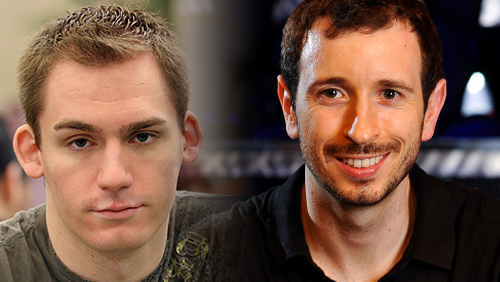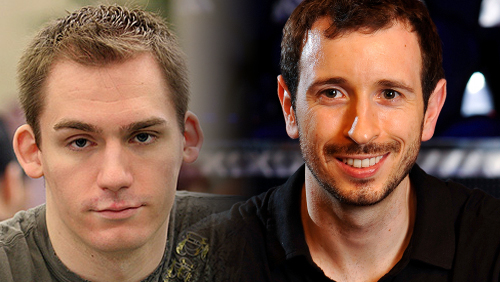 The $50,000 Poker Player’s Championship is one of the greatest poker tournaments in the world. It separates the men from the boys. But does this mean that the 2016 winner’s story is about greatness, or could it be about humility?
The $50,000 Poker Player’s Championship is one of the greatest poker tournaments in the world. It separates the men from the boys. But does this mean that the 2016 winner’s story is about greatness, or could it be about humility?
The [Ks] hits the felt. Brian Rast checks the action over to Justin Bonomo. This was it. This was the moment. All the pain; all the sorrow; all of the close shaves. It was the big one. It was the $50,000 Poker Players Championship – the competition that crowns the card-for-card greatest poker player in the world.
A hush falls over the crowd.
All eyes turn to Bonomo.
“All-in.”
When thinking about the theme of this article, I settled on the competitiveness of humanity and our desire to be the best. Then after reading Brian Rast’s thoughts in the aftermath of his epic heads-up encounter against Justin Bonomo I decided I needed to change my focus.
When the cards finishing flying, the bracelet was handed over, and the money wired to the appropriate accounts, the defining moments in the $50,000 PPC were not about competition and the desire to be the best – they were about humility.
34-year old Brian Rast, from Denver Colorado, has been playing poker at the highest levels in the game for years. He has cashed in the World Series of Poker (WSOP) 29 times, made 9 final tables, and before the manic mayhem of the 2016 PPC final table, he had won two bracelets.
Both of those bracelet wins came in 2011 when he won a $1,500 Pot-Limit Omaha (PLO) event, and won the $50,000 PPC for $1.7m. And here he was again trying to become only the second player in history to win the event twice.
Standing in his way is a young man playing some of the best poker in his life. Justin Bonomo was cashing in the 2016 WSOP for the sixth occasion. He had finished 2nd in the $1,500 H.O.R.S.E, 2nd in the $10k No-Limit Hold’em (NLHE) 6-Max Championship, and 3rd in the $10k Seven Card Stud Hi-Lo Split-8 or Better Championship.
He had one bracelet on his CV, but that doesn’t tell half the tale. Bonomo was appearing as one of the final five players in WSOP competitions for the 12th time. That’s a few river cards difference between being great and being the greatest.
How You Define ‘The Greatest’ in Poker Terms?
With so many derivatives of poker, and so many ways to play those derivatives, it’s difficult to say who is the card-for-card best player in the world. And it’s a problem, because although it’s undisputed that the $10,000 WSOP Main Event is the greatest tournament in the world, the cream very rarely rises to the top.
In 2006, the WSOP stumbled across an idea that could change this when they created an event that stretched poker’s elite to the absolute limits. A buy-in level was set at $50,000 to ensure only those in the top tier, and those with money would enter. Player’s would battle it out in all forms of poker. They called it the Poker Player’s Championship. And the winner of that event was many people’s vote for the card-for-card best player in the world: Chip Reese. After his death in 2007, the WSOP created the Chip Reese trophy in his honour.
But does the formula work?
Do the world’s most proficient poker players rise to the top?
Freddy Deeb won in 2007, Scotty Nguyen won in 2008, and David Bach won in 2009 – all great players in their own right, but masters of the poker universe?
So what if you won the event twice: Surely, then we would meet the best card-for-card poker player in the world. The first player to accomplish that feat was Michael ‘The Grinder’ Mizrachi in 2010 & 2012. As interesting and exciting as The Grinder is, it shows there is a flaw in that idea also.
And that’s what Brian Rast was aiming to do as he looked across the table at Justin Bonomo. Rast first won the PPC in 2011 earning $1.7m in the process. Now, only Bonomo stood in his way of becoming the second player to win the title twice.
To win the PPC you have to play over 50-hours of poker, over a five day period, against the world’a best players in Seven-Card Stud, No-Limit Hold’em, Deuce-to-Seven Triple Draw, Seven-Card Stud High-Low Split, Omaha High-Low Split, Pot-Limit Omaha, Limit Hold’em, and Razz.
It’s a marathon.
91 entered the event this year, the second time in successive years that the number of entrants had fallen below the 100-entrant mark. The prize pool was $4,176,000. Both Rast and Bonomo were guaranteed $801,048. The winner would walk away with $1,296,097.
Justin Bonomo v Brian Rast
The dealer shuffles the deck and flings the first cards in the general direction of these two warriors. Bonomo would start the match with a 14.2m v 8.5m chip lead.
It was Rast who came out of the gates the fastest winning several Omaha Hi-Lo and Seven Card Stud hands to take the chip lead. Bonomo reacted well. The lead changed hands once more. It wouldn’t be the last time that would happen over the next three hours.
Omaha Hi-Lo – Bonomo raises from the button and Rast calls. The flop is [Jh] [7s] [4c]; Rast checks, Bonomo bets, and Rast calls. The turn is the [5d] and the same action ensues. The river is the [9c]; and for the third time Rast check-calls. Bonomo shows [Qd] [Qc] [8d] [6s] for the straight, Rast mucks, and Bonomo scoops the pot to move into a 16.6m v 6.5m chip lead.
Bonomo looks confident. Rast is in trouble. Bonomo then puts together a nice little run in Razz and stretches his lead to 4:1. Rast is on the floor. He is down, but he’s not out.
PLO – Rast raises on the button and Bonomo calls. The flop is [Kd] [9c] [5s]; Bonomo checks, Rast bets 415k and Bonomo calls. The turn is the [7c] and both players check. The river is the [2h]; Bonomo checks, Rast bets 950k, and Bonomo calls. Rast shows [5c] [3s] [2s] [2c] for a set of deuces and Bonomo mucks.
The gap closes to 15.3m v 7.4m.
Momentum.
It’s a beautiful thing.
Rast goes with the flow, wins some important Seven Card Stud Hi-Lo hands and suddenly an eight low and set of fours later he is the chip leader.
Bonomo snatches it back.
Rast takes it back.
Bonomo takes it back.
Rast takes it back.
It’s Razz and Rast extends his lead to a 2:1 advantage. It’s PLO and Rast moves even further ahead to a 4:1 chip advantage. He can see the finishing line. It’s a familiar sight. He has felt all of these sensations before; Bonomo is feeling them for the first time and it’s starting to show.
It’s Limit Hold’em, and Bonomo digs deep into his reserves and comes out with a series of winning pots to close the gap. Next the players switch their minds to 2-7 Triple Draw and remarkably Bonomo takes the chip lead.
Moving from the milk float of poker games to the Cadillac of poker games and Rast opens up a slight lead.
And then…
Bonomo raises to 400k on the button and Rast calls. The flop is [As] [Td] [5c]; Rast checks, Bonomo c-bets for 350k, and Rast calls. The turn is [Ac]; Rast checks, Bonomo bets 2.2m. Rast ponders his decision for a moment and then calls.
The dealer puts the [Ks] out on the river and we are right back where this whole journey began, with Bonomo going through the ranges, knowing that his next move will likely determine who wins this competition, and then he moves all-in.
There is no pause.
There is no whirring of cogs in Rast’s brain.
He calls in a heartbeat, and in that moment, Bonomo knows that his hopes of winning this event have gone up in smoke. Bonomo turned over [Qc] [Js] for Broadway, but Rast shows [Ad] [Ts] for the boat.
Bonomo stands up from his chair. The paradox of winning over $800,000 and still feeling like a loser enters his mind. They pair shakes hands. There is a silent acknowledgement between the pair that you see between all the greatest sportsmen in the world. They have both been in a battle, and they know it.
For Bonomo, it’s another runner-up finish. For Rast, it’s his third bracelet, his fifth seven figure score, and he overtakes Jonathan Duhamel and Jason Mercier to move into the Top 10 All Time Live Tournament earners. He has also won the PPC two times, and only The Grinder has done that before.
So.
Does this mean that Rast is the best card-for-card poker player in the world?
“For me I play so much poker, I play for really high-stakes all the time.” Rast tells the WSOP after his win.”So, I’m not always playing tournaments — I’m mostly a cash game player. But since I play the biggest cash game limits in almost every game, I think that does say something professionally. Tournament results have a lot of luck involved. I was blessed to run really good in events that were so big. There are plenty of other great players who weren’t as fortunate. While I feel I played well, that’s not all of that and I realize it.”
And that’s why this story is about humility.
